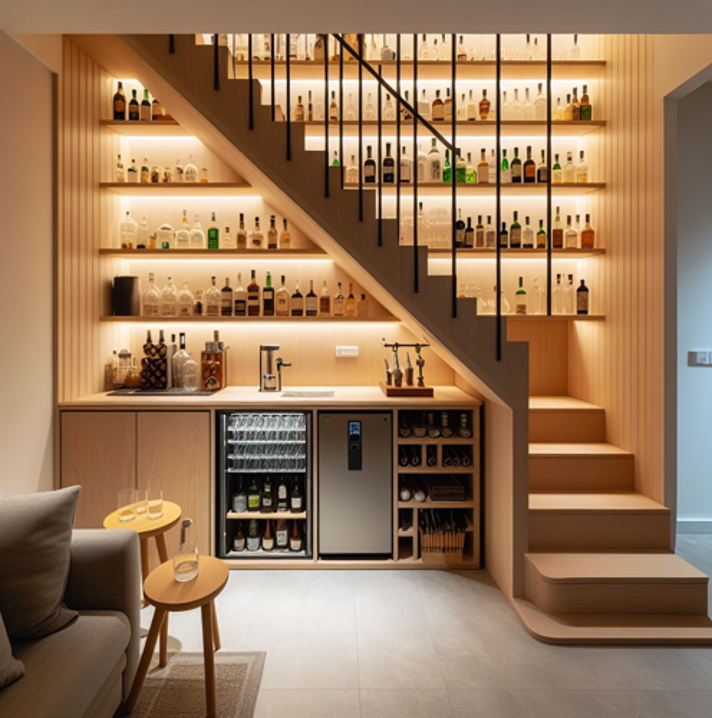Guest blog post by: Indiana Lee
Your interior design choices reflect your personality. A Scandinavian-inspired open-floor plan says that you enjoy order and cleanliness, while a bohemian vibe shows that you like coziness and bold statement pieces.
That’s why ‘dead spaces’ can be so frustrating. These so-called ‘dead spaces’ are divorced from your overall design plan and usually look unfinished compared to the rest of your home.
However, it doesn’t have to be that way. With a few strategic changes, you can transform these dead spaces into statement nooks that are functional and look great too.
Window Nooks
Window nooks can be tricky spaces to use if you can’t find a bench seat that will perfectly fit the depth of your nook. A dinky little bench could make it look like an afterthought, while a big bulky chair would fill the space, blocking out sunlight and your view.
If you're crafty, try making your own pillows for the nook. An easy place to start is by sewing a simple box pleat seat cushion with a material that ties in with your existing decor. For example, if you like a coastal theme, stick to baby blues or sand-colored fabrics.
If you want to make custom changes to your window nook, bring in a carpenter who can build you a functional space. They might have the perfect design in mind to add in seating with storage underneath. Imagine having a great new window seat to sit on as you sip your morning coffee and enjoy some peace and a great view. Sounds pretty good, right?
If the space still looks a little empty, consider framing the nook with flowers. This brings the outdoors in and helps you create a calming vibe. Look for seasonal flowers when shopping for plants. This will create a connection between your home and the outdoors.
Hallways
Hallways are always tricky spaces to decorate. They’re, by definition, transitional spaces that aren’t quite rooms. Hallways in the center of your home can be an especially big headache because they chop up your rooms. They’re usually too narrow to place furniture in and too long to leave undecorated because that would look odd. Fortunately, there are plenty of ways to transform your blank hallways:
Create a mini library with picture ledge shelves or built-in bookcases.
If you have a wider hallway, make use of the space by setting up a small home office.
Set aside some room for your pet by installing cat trees or dog houses.
Reflect your personality by creating a gallery wall showing your favorite art and artists.
Simple changes like these will transform blank walls and help you make use of these tricky areas. the unoccupied area.
This is key if you’re planning on selling your house.
Showing a perspective buyer a thoughtful, well-designed hallway will emphasize what makes your house special.
Installing a small office space or a mini library can declutter other rooms and help potential buyers imagine themselves living in the space.
Other ways that hallway nooks increase the value of your home and help you sell your home fast include:
Staging: Hallway nooks are the perfect place to stage fresh-cut flowers and scented candles.
Furniture: Use hallway furniture to store pets' toys and reduce visual clutter.
Personality: Creating a gallery wall in the hallway helps give your space a sense of intention and personality.
Taking time to redesign your hallways can help you keep your house clean, too.
Multipurpose storage items like large trunks look great and are the perfect place to keep pet toys and kid’s games when they’re not in use.
Extra Rooms
When you first move into a new home, the idea of an extra room is exciting.
You could create a home library, a personal cinema, or a large walk-in wardrobe.
However, it’s easy to overlook the potential of these spaces for so long that they eventually become little more than ‘dead’ storage nooks filled with junk and clutter.
Reignite your passion for decorating your house by tackling your extra room(s) head-on! When you stand boldly in your intention to DIY a space like this, you’re likely to experience a shift in mindset that can be freeing, especially if you’re used to making “safe” design decisions. A project you can sink your teeth into can be great fun. If you’re stumped for ideas, consider bold, practical options like:
Walk In Closet.
At-Home Library.
Crafting Room.
Meditation Space.
A word of caution though, if you are planning on doing any kind of major renovation, like knocking down walls or redoing floors, it may be best to bring in a professional. This is especially the case in terms of electrical changes. The dangers of DIY electrical wiring are not to be overlooked, as mistakes can cause injury, inspection failures, and fires. It is always best to hire an electrician if you’re not sure how to install wiring.
Once you’ve taken care of safety concerns, you can start to redesign your previously overlooked ‘dead’ room. Let this space be a reflection of your personality by brining in memorabilia and personal stuff that mean a lot to you. This can turn your unused room into a sanctuary space, helping you relax and work on your favorite hobbies.
Under the Stairs
Utilizing the angular space under the stairs can be a real headache too.
You can’t fit anything meaningful in the area and may be tempted to cram it with boxes or clutter. Some folks fill this space in to remove the confusion all together. However, with a little innovation and passion for design, you’ll be able to find creative ways to fill this dead space.
Maybe you love to read. The space under the stairs is a great place for a book nook. You can line the area with bookshelves and install an upholstered reading bench for comfortable seating. Bring in some adjustable overhead lighting and set aside a little spot to hold your teacup or coffee mug.
If you’re not much of a reader, consider converting the under-stairs space into a bar or wine nook. This is a perfect way to show off your wine and barware. and gives the area an intentional, adult hangout vibe. An under-stairs wine cellar can also be a real boon if you plan on hosting friends and throwing parties, too.
When drawing up plans for your space under the stairs, pay attention to the existing architecture. If you live in an old home with winding stairs, you may find that the space has an aesthetic quality of its own right. In this case, leave the area open and use it for functional items like shoe and coat storage. This highlights the bones of your home and can make the whole space look larger than it really is.
Conclusion
Neglected nooks can undermine your creative vision and sap your passion for decorating your house. But, with the right approach, these ‘dead spaces’ can become a hallmark of your style. Even simple changes, like adding pillows and throws to window nooks, can make your space seem more ‘designed’, bringing new life to neglected areas.
Also, integrating effective pest management into your design strategy helps keep these spaces inviting and clean, ensuring your home remains stylish and functional. This includes sealing gaps, using pest-repellent plants, and ensuring that storage areas are rodent-proof. Taking these steps protects your investment and enhances the overall comfort and hygiene of your living spaces.
Read Next:
Affordable Home Refresh: Making Over Your Pre-Owned House
Transform your pre-owned house into the home of your dreams without breaking the bank! You’ll learn budget-friendly tips to revamp your space. From modernizing with a fresh coat of paint to upgrading focal points, we've got you covered. Dive into cohesive design, eco-friendly upgrades, and savvy tricks to reimagine unwanted features. This one’s all about creativity on a budget!
Join the Fun!
If you enjoyed this post and you want to keep seeing my weekly blog, the best way to do that is to subscribe.
You can subscribe by downloading my 11 Secrets Only Designers Know to Make Your Space Rock. If you’re curious about how decorators and designers make a home look magazine ready, you’ll love taking a gander at these 11 secrets. You’ll learn how to style your room from the floor up and it will work for ANY space you have.
I write about small space design and decorating, sustainable furniture options, positive self care and a variety of do-it-yourself home décor.
I’d love to connect with you!
“Michael Helwig was top-notch, very professional and responsive to my needs. He allowed me time to explore ideas and try out a variety of combinations until we found the perfect fit. Michael provided detailed information and offered beautiful ideas to make my dream living room become a reality. The furniture he sourced has totally transformed my living room space. Everyone that has seen my new living room has one word, WOW! A special thank you to Michael for a wonderful experience.”
“Michael was very knowledgeable and guided us, with great patience and good humor, through the process of designing our dining room and helping us find the perfect sleeper sofa. He offered really helpful advice when we asked questions - which was often - but at no time did we ever feel pushed. He helped me when I felt like I couldn’t make one more decision. When my new furniture finally arrived I realized everything down to the pillows was perfect. I couldn’t be happier!”
The opinions and views expressed in any guest blog post do not necessarily reflect those of Michael Helwig Interiors or its Principal, Michael Helwig. Michael Helwig Interiors, and Michael Helwig, do not have any affiliations with any products or services mentioned in the article or linked to therein. Guest Authors may have affiliations to products mentioned or linked to in their articles or bios.
Indiana Lee is a passionate writer and avid puzzle enthusiast hailing from the serene landscapes of the Pacific Northwest. With a deep appreciation for aesthetics and a strong preference for designs that seamlessly blend comfort and functionality, she brings a unique perspective to the world of interior decor. Connect with her on LinkedIn.
















